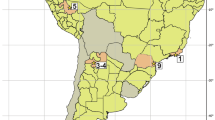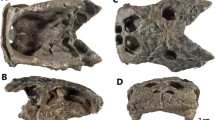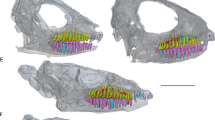Abstract
Recent histological studies have revealed a diversity of dental features in Permo-Carboniferous tetrapods. Here, we report on the occurrence of plicidentine (infolded dentine around the base of the tooth root) in Sphenacodontia, the first such documentation in Synapsida, the clade that includes mammals. Five taxa were examined histologically, Ianthodon schultzei, Sphenacodon ferocior, Dimetrodon limbatus, Dimetrodon grandis, and Secodontosaurus obtusidens. The tooth roots of Ianthodon possess multiple folds, which is generally viewed as the primitive condition for amniotes. Sphenacodon and D. limbatus have distinctive “four-leaf clover”-shaped roots in cross section, whereas Secodontosaurus has an elongate square shape with only subtle folding. The most derived and largest taxon examined in this study, D. grandis, has rounded roots in cross section and therefore no plicidentine. This pattern of a loss of plicidentine in sphenacodontids supports previous functional hypotheses of plicidentine, where teeth with shallow roots require folds to increase the area of attachment to the tooth-bearing element, whereas teeth with long roots do not. This pattern may also reflect differences in diet between co-occurring sphenacodontids as well as changes in feeding niche through time, specifically in the apex predator Dimetrodon.







Similar content being viewed by others
References
Abler WL (1992) The serrated teeth of tyrannosaurid dinosaurs, and biting structures in other animals. Paleobiology 18:161–183
Benson RBJ (2012) Interrelationships of basal synapsids: cranial and postcranial morphological partitions suggest different topologies. J Syst Palaeontol 10:601–624
Berman DS (1978) Ctenospondylus ninevehensis, a new species (Reptilia, Pelycosauria) from the lower Permian Dunkard group of Ohio. Ann Carnegie Mus 47:493–514
Brink KS, Reisz RR (2014) Hidden dental diversity in the oldest terrestrial apex predator Dimetrodon. Nat Comm 5. doi:10.1038/ncomms4269
Brink KS, Campione NE, Hawthorn JR (2013) Amniote faunal revision of the Pictou Group (Permo-Carboniferous), Prince Edward Island, Canada. C R Palevol 12:473–485
Brocklehurst N, Fröbisch J (2014) Current and historical perspectives on the completeness of the fossil record of pelycosaurian-grade synapsids. Palaeogeogr Palaeocl 399:114–126
Case EC (1907) Revision of the Pelycosauria of North America. Carnegie Institution of Washington, D.C.
Cope ED (1878) Descriptions of extinct Batrachia and Reptilia from the Permian Formation of Texas. Proc Am Phil Soc 17:505–530
Cope ED (1881) On some new Batrachia and Reptilia from the Permian Beds of Texas. Bull U S Geol Geogr Surv Terr 6:79–82
de Ricqlès A, Bolt JR (1983) Jaw growth and tooth replacement in Captorhinus aguti (Reptilia: Captorhinomorpha): a morphological and histological analysis. J Vertebr Paleontol 3:7–24
DiMichele WA, Hook RW (1992) Paleozoic terrestrial ecosystems. In: Behrensmeyer AK, Damuth JD, DiMichele WA, Potts R, Sues H-D, Wing SL (eds) Terrestrial ecosystems through time. University of Chicago Press, Chicago, pp 205–325
Eberth DA (1985) The skull of Sphenacodon ferocior, and comparisons with other sphenacodontines (Reptilia: Pelycosauria). Circ New Mex Bur Mine Miner Resour 190:1–38
Evans DC, Maddin HC, Reisz RR (2009) A re-evaluation of sphenacodontid synapsid material from the Lower Permian fissure fills near Richards Spur, Oklahoma. Palaeontology 52:219–227
Falconnet J (2014) The sphenacodontid synapsid Neosaurus cynodus, and related material, from the Permo-Carboniferous of France. Acta Palaeontol Pol. doi:10.4202/app.2012.0105
Fröbisch J, Schoch RR, Müller J, Schindler T, Schweiss D (2011) A new basal sphenacodontid synapsid from the Late Carboniferous of the Saar-Nahe Basin, Germany. Acta Palaeontol Pol 56:113–120
Gao K, Fox RC (1998) New choristoderes (Reptilia: Diapsida) from the Upper Cretaceous and Palaeocene, Alberta and Saskatchewan, Canada, and phylogenetic relationships of Choristodera. Zool J Linn Soc 124:303–353
Herring SW (1993) Functional morphology of mammalian mastication. Am Zool 33:289–299
Hill RV (2005) Integration of morphological data sets for phylogenetic analysis of Amniota: the importance of integumentary characters and increased taxonomic sampling. Syst Biol 54:530–547
Huttenlocker A, Rega E, Sumida S (2010) Comparative anatomy and osteohistology of hyperelongate neural spines in the sphenacodontids Sphenacodon and Dimetrodon (Amniota: Synapsida). J Morphol 271:1407–1421
Kearney M, Rieppel O (2006) An investigation into the occurrence of plicidentine in the teeth of squamate reptiles. Copeia 2006:337–350
Kissel RA, Reisz RR (2004) Synapsid fauna of the Upper Pennsylvanian Rock Lake Shale near Garnett, Kansas and the diversity pattern of early amniotes. In: Arratia G, Wilson MVH, Cloutier R (eds) Recent advances in the origin and early radiation of vertebrates. Verlag, München, pp 409–428
Lamm E-T (2013) Preparation and sectioning of specimens. In: Padian K, Lamm E-T (eds) Bone histology of fossil tetrapods: advancing methods, analysis, and interpretation. University of California Press, pp 55–160
Laurin M (1993) Anatomy and relationships of Haptodus garnettensis, a Pennsylvanian synapsid from Kansas. J Vertebr Paleonotol 13:200–229
Laurin M, Reisz RR (1997) A new perspective on tetrapod phylogeny. In: Sumida S, Martin KLM (eds) Amniote origins: completing the transition to land. Academic Press, San Diego, pp 9–61
LeBlanc ARH, Reisz RR (2013) Periodontal ligament, cementum, and alveolar bone in the oldest herbivorous tetrapods, and their evolutionary significance. PLoS One 8:e74697
MacDougall MJ, LeBlanc ARH, Reisz RR (2014) Plicidentine in the Early Permian parareptile Colobomycter pholeter, and its phylogenetic and functional significance among coeval members of the clade. PLoS One. doi:10.1371/journal.pone.0096559
Maxwell EE, Caldwell MW, Lamoureux DO (2011a) The structure and phylogenetic distribution of amniote plicidentine. J Vertebr Paleonotol 31:553–561
Maxwell EE, Caldwell MW, Lamoureux DO (2011b) Tooth histology, attachment, and replacement in the Ichthyopterygia reviewed in an evolutionary context. Paläont Z 86:1–14
Maxwell EE, Caldwell MW, Lamoureux DO, Budney LA (2011c) Histology of tooth attachment tissues and plicidentine in Varanus (Reptilia: Squamata), and a discussion of the evolution of amniote tooth attachment. J Morphol 272:1170–1181
Meunier FJ, De Mayrinck D, Brito PM (2014) Presence of plicidentine in the labial teeth of Hoplias aimara (Erythrinidae; Ostariophysi; Teleostei). Acta Zool. doi:10.1111/azo.12065
Modesto SP, Reisz RR (2008) New material of Colobomycter pholeter, a small parareptile from the Lower Permian of Oklahoma. J Vertebr Paleontol 28:677–684
Olson EC (1966) Community evolution and the origin of mammals. Ecology 47:291–302
Preuschoft H, Reif W-E, Loitsch C, Tepe E (1991) The function of labyrinthodont teeth: big teeth in small jaws. In: Schmidt-Kittler N, Vogel K (eds) Constructional morphology and evolution. Springer, Berlin, pp 151–171
Rayfield EJ (2004) Cranial mechanics and feeding in Tyrannosaurus rex. Proc Roy Soc Lond B Biol Sci 271:1451–1459
Reichel M (2010) The heterodonty of Albertosaurus sarcophagus and Tyrannosaurus rex: biomechanical implications inferred through 3-D models. Can J Earth Sci 47:1253–1261
Reisz RR (1986) Pelycosauria. In: Kuhn O (ed) Handbuch der palaoherpetologie, vol 17A, Gustav Fischer Verlag. Stuttgart, Germany, pp 1–102
Reisz RR (2006) Origin of dental occlusion in tetrapods: signal for terrestrial vertebrate evolution? J Exp Zool 306B:261–277
Reisz RR, Berman DS, Scott D (1992) The cranial anatomy and relationships of Secodontosaurus, an unusual mammal-like reptile (Synapsida: Sphenacodontidae) from the early Permian of Texas. Zool J Linn Soc 104:127–184
Romer AS (1928) Vertebrate faunal horizons in the Texas Permo-Carboniferous red beds. Univ Tex Bull 2801:67–108
Romer AS, Price LW (1940) Review of the Pelycosauria. Spec Pap Geol Soc Am 28:538
Roopnarine PD, Angielczyk K (2012) The evolutionary palaeoecology of species and the tragedy of the commons. Biol Lett 8:147–150
Scanlon JD, Lee MS (2002) Varanoid-like dentition in primitive snakes (Madtsoiidae). J Herpetol 36:100–106
Schultze H-P (1969) Die Faltenzähne der Rhipidistiiden Crossopterygier, der Tetrapoden und der Actinopterygier-Gattung Lepisosteus; nebst einer Beschreibung der Zahnstruktur von Onychodus (Struniiformer Crossopterygier). Palaontograph Ital 35:63–137
Schultze H-P (1970) Folded teeth and the monophyletic origin of tetrapods. Am Mus Nov:2408
Shelton CD, Sander PM, Stein K, Winkelhorst H (2013) Long bone histology indicates sympatric species of Dimetrodon (Lower Permian, Sphenacodontidae). Trans Earth Sci 103:217–236
Smith JB, Dodson P (2003) A proposal for a standard terminology of anatomical notation and orientation in fossil vertebrate dentitions. J Vertebr Paleontol 23:1–12
Snively E, Henderson DM, Phillips DS (2006) Fused and vaulted nasals of tyrannosaurid dinosaurs: implications for cranial strength and feeding mechanics. Acta Palaeontol Pol 51:435
Van Valkenburgh B, Jenkins I (2002) Evolutionary patterns in the history of Permo-Triassic and Cenozoic synapsid predators. In: Kowalewski M, Kelley PH (eds) The fossil record of predation, vol 8. Paleontological Society Papers, pp 267–288
Warren AA, Davey L (1992) Folded teeth in temnospondyls—a preliminary study. Alcheringa 16:107–132
Warren A, Turner S (2006) Tooth histology patterns in early tetrapods and the presence of ‘dark dentine’. Trans Earth Sci 96:113–130
Acknowledgments
For access to specimens and assistance with thin sectioning, we thank B. Iwama, I. Morrison, and K. Seymour of ROM; O. Dülfer, M. Sander, A. Schmitt, and C. Shelton of StIPB; and D. Fisher and J. Wilson of UMMP. For the illustration in Fig. 7, we thank Frederik Spindler. For discussion, we thank C. Brown, K. Chiba, D. Dufault, D. Evans, J. Hawthorn, D. Larson, M. MacDougall, and D. Scott (University of Toronto). Funding was provided by an NSERC discovery grant to R. Reisz.
Author information
Authors and Affiliations
Corresponding author
Additional information
Communicated by: Sven Thatje
Rights and permissions
About this article
Cite this article
Brink, K.S., LeBlanc, A.R.H. & Reisz, R.R. First record of plicidentine in Synapsida and patterns of tooth root shape change in Early Permian sphenacodontians . Naturwissenschaften 101, 883–892 (2014). https://doi.org/10.1007/s00114-014-1228-5
Received:
Revised:
Accepted:
Published:
Issue Date:
DOI: https://doi.org/10.1007/s00114-014-1228-5




